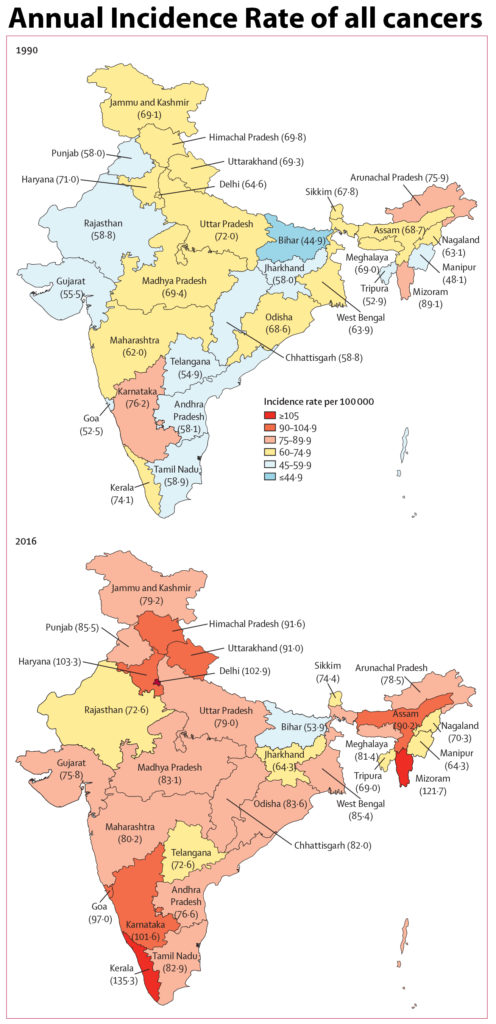
Experts highlight the need to understand and address this trend as the first analysis of the state level disease burden data is released
- Prevalence of ischemic heart disease and stroke has increased by over 50% from 1990 to 2016 in India, with an increase observed in every state.
- The number of persons with diabetes in India has increased from 26 million in 1990 to 65 million in 2016.
- The rate of increase in the burden of ischemic heart disease and diabetes has been the highest in the less developed states of India, where the burden of chronic obstructive lung disease and infectious conditions is already high.
- The proportional contribution of cancers to the total health loss in India has doubled from 1990 to 2016, but the incidence of different types of cancers varies widely between the states with Mizoram having the highest incidence and death rate
- Suicide is presently the leading cause of death in the 15-39 year age group in India
- 37% of the total global suicide deaths among women occur in India, and suicide death rate among the elderly has increased over the past quarter century.
These are some of the findings of an analysis of the first ever state level disease burden in India.
A joint initiative of the Indian Council of Medical Research (ICMR), Public Health Foundation of India (PHFI), and Institute for Health Metrics and Evaluation (IHME) in collaboration with the ministry of health, the findings were released today. They have been reported in a series of five research papers published in The Lancet Global Health, The Lancet Public Health, and The Lancet Oncology, along with a commentary in The Lancet.
“The ability of a health system to respond to immediate and anticipated future challenges depends on estimates of major disease burdens and their evolving trends.”
Professor Balram Bhargava, secretary department of health research and director general of ICMR said: “The proportional contribution of cancers to disease burden in India has doubled since 1990, but the incidence of individual cancers varies widely between the states, the reasons for which need to be understood better to guide prevention and control of cancer. Another important finding is the very high contribution of India to the total suicide deaths in the world, especially among women. The ten-fold variation between the states in the suicide death rate for women emphasises the need to better understand the reasons behind these suicides and make concerted efforts to reduce this avoidable loss of predominantly young lives.”

India, 1990 and 2016
The states of Chhattisgarh, Jharkhand, Telangana, and Uttarakhand did not exist
in 1990, as they were created from existing larger states in 2000 or later. Data
for these four new states were disaggregated from their parent states based on
their current district composition. These states are shown in the 1990 map for
comparison with 2016.
Reacting to the findings, Niti Ayog member Prof Vinod Paul said that they come just at the right time and would be valuable inputs for the planning of Ayushman Bharat, Pradhan Mantri jan Arogya Yojana that is set to be rolled out on September 23.
“The ability of a health system to respond to immediate and anticipated future challenges depends on estimates of major disease burdens and their evolving trends. The response also has to be appropriate to the context of each state. This study not only profiles how NCDs and suicide are posing menacing public health challenges across the country, but also enables a contextually configured health system response suitable for each state,” said Professor K Srinath Reddy, President, Public Health Foundation of India.














[…] 37% of the total global suicides among women occur in India and suicide rate among the elderly has increased over the past quarter century.Read More […]
Comments are closed.